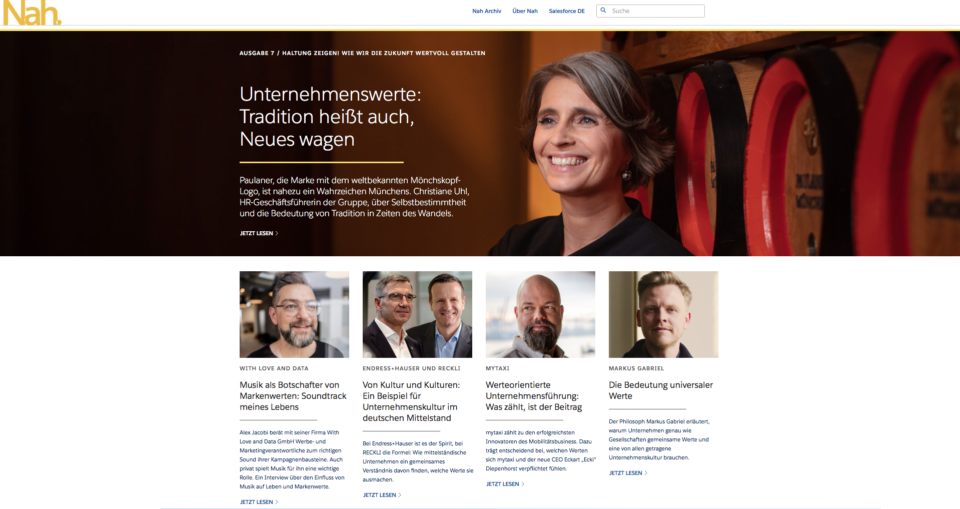20 years of Salesforce – A Success Story
Twenty years is a long time. When you celebrate your twentieth birthday, you have been an adult for two years already, have a driver’s license, have graduated from school and are starting your career. Companies also have something to celebrate when they break twenty. In a time of constant change, staying in the market for so long is not a matter of course. The Salesforce founders probably didn’t really think so either. But they did it. This year they are celebrating twenty years of Salesforce.
The story behind the company
March San Francisco 1999: Marc Benioff, Parker Harris, Dave Moellenhoff and Frank Dominguez founded Salesforce in a one-bedroom apartment. The reasons? They wanted to make software as easy to use as Amazon. To this end, operating applications should be offered directly via the Internet, without additional software. Benioff and co. have succeeded in doing just that. Even after 20 years, Salesforce is still one of the fastest growing software companies and is now number 1 in the CRM sector. Over 150,000 Salesforce customers worldwide have already achieved their goals, e.g. better marketing.
“Ohana” and charitable commitment
The philosophy of the giant from San Francisco is “Ohana”. The Hawaiian word means family. This is exactly what the giant from the USA wants to present to its customers, employees and community. The company’s core values are also based on this. These include innovation, trust, growth, transparency, customer success, social commitment, well-being, fun and equality. The 1-1-1 system was introduced with the Salesforce.org foundation. In the process, 1% of resources are made available for charitable projects. This corresponds to seven paid days for each employee to carry out charitable work, 1% of equity is used as donations, mostly for regional projects, and 1% of products can be used free of charge by non-profit organizations.

The history of customers
Whether you are a small start-up or a global giant, Salesforce has the right solution for everyone. The common goal is to build a deep and valuable relationship with customers. The cloud with its various customer service, sales and marketing features simplifies interaction with the target group. One example is Lemoncat. I’m sure many people are familiar with the lunch dilemma. What are you hungry for and where can you get the food as quickly as possible? In the age of Lieferheld and the like, this is no longer a problem for individuals but it can be for companies. Doreen Huber thought the same thing and founded Lemoncat in 2016. A catering platform where companies can easily find, book and then pay for suitable offers from the region. It doesn’t matter whether it’s a business meeting or lunch together. This saves time and money. The start-up still needed a reliable partner for this entire process and found one in Salesforce. With the Sales Cloud the digitalization of catering can be implemented quickly. The application was adapted to Lemoncat’s needs so that employees could use it quickly.
Storytelling and 20 years of success
Be it descriptive videos, reports or photos, at Salesforce everything seems to have a story. The company from San Francisco is not necessarily the hero of the story. The company acts as a mentor to its customers and supports them. But the employees’ stories are also shaped by their work. Be it the day-to-day work, the social commitment or also learnings that employees had. It is listened to and then reported on various channels such as Facebook, Twitter and LinkedIn.
A #dualesStudium is the perfect combination for Leonard Klein and Pauline Rößle! You can find out why the two students chose #Salesforce here: https://t.co/VsZ2iFOdMj pic.twitter.com/zO1oM8CaFo
– Salesforce Germany (@SalesforceDE) June 4, 2019

Focus on the customer
The customer magazine Nah. provides information about the number 1 company for CRM and focuses on the users of Sales Cloud and Co. It is not only the successes that count but also the challenges, solutions and experiences. The magazine also provides information on the innovations that are making Germany excited about the technology of the future and the Trailblazers, the pioneers of digital change. The Trailblazers were created by Trailhead, a continuing education program.

Videos for story visualization
Videos of customers, products and employees are published on YouTube. Their stories, whether hobbies, strokes of fate or the path they have taken in life, form the focus. They take on the role of the hero. One example of this is the “Make a Change Women” video series. Here, women in senior management positions talk about what drives them in life, what is important to them and their recipe for success. Take Stephanie Buscemi for example, who has had many mentors in her life who have helped her both professionally and personally. She now wants to pass this on to others and be a mentor too. Or Sarah Franklin, who works as a woman in a technical profession and has been confronted with many prejudices. She has asserted herself and now wants to help making changes for other women as a mentor.
Conclusion: Successful together with “Ohana”
Salesforce creates the feeling that everyone can be a hero and that it is almost child’s play to implement as a team. Despite its size, the company continues to adhere to its family philosophy Ohana. The company’s storytelling makes a major contribution to its success. Be it employer branding or the presentation of products, everything has a story that Salesforce skillfully stages. Customers and employees listen, watch and are captivated by Salesforce’s various stories. Their goal is to become the number one provider of cloud solutions.
Share this article








